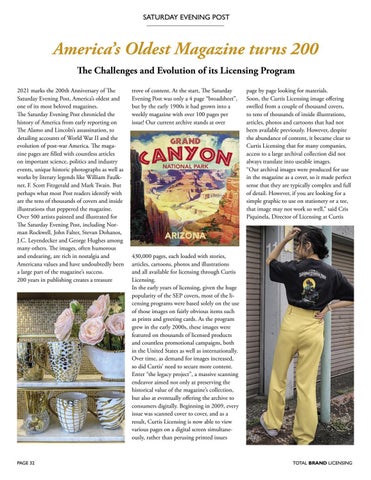SATURDAY EVENING POST
America’s Oldest Magazine turns 200 The Challenges and Evolution of its Licensing Program 2021 marks the 200th Anniversary of The Saturday Evening Post, America’s oldest and one of its most beloved magazines. The Saturday Evening Post chronicled the history of America from early reporting on The Alamo and Lincoln’s assassination, to detailing accounts of World War II and the evolution of post-war America. The magazine pages are filled with countless articles on important science, politics and industry events, unique historic photographs as well as works by literary legends like William Faulkner, F. Scott Fitzgerald and Mark Twain. But perhaps what most Post readers identify with are the tens of thousands of covers and inside illustrations that peppered the magazine. Over 500 artists painted and illustrated for The Saturday Evening Post, including Norman Rockwell, John Falter, Stevan Dohanos, J.C. Leyendecker and George Hughes among many others. The images, often humorous and endearing, are rich in nostalgia and Americana values and have undoubtedly been a large part of the magazine’s success. 200 years in publishing creates a treasure
PAGE 32
trove of content. At the start, The Saturday Evening Post was only a 4 page “broadsheet”, but by the early 1900s it had grown into a weekly magazine with over 100 pages per issue! Our current archive stands at over
page by page looking for materials. Soon, the Curtis Licensing image offering swelled from a couple of thousand covers, to tens of thousands of inside illustrations, articles, photos and cartoons that had not been available previously. However, despite the abundance of content, it became clear to Curtis Licensing that for many companies, access to a large archival collection did not always translate into useable images. “Our archival images were produced for use in the magazine as a cover, so it made perfect sense that they are typically complex and full of detail. However, if you are looking for a simple graphic to use on stationery or a tee, that image may not work so well,” said Cris Piquinela, Director of Licensing at Curtis
430,000 pages, each loaded with stories, articles, cartoons, photos and illustrations and all available for licensing through Curtis Licensing. In the early years of licensing, given the huge popularity of the SEP covers, most of the licensing programs were based solely on the use of those images on fairly obvious items such as prints and greeting cards. As the program grew in the early 2000s, these images were featured on thousands of licensed products and countless promotional campaigns, both in the United States as well as internationally. Over time, as demand for images increased, so did Curtis’ need to secure more content. Enter “the legacy project”, a massive scanning endeavor aimed not only at preserving the historical value of the magazine’s collection, but also at eventually offering the archive to consumers digitally. Beginning in 2009, every issue was scanned cover to cover, and as a result, Curtis Licensing is now able to view various pages on a digital screen simultaneously, rather than perusing printed issues
TOTAL BRAND LICENSING




















